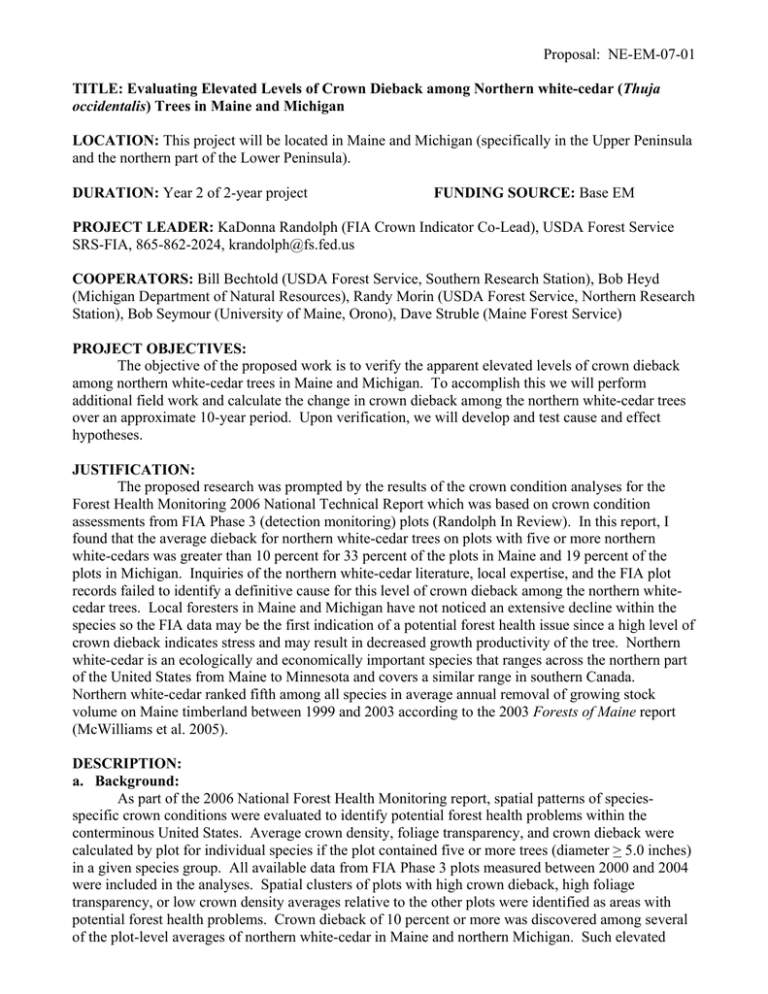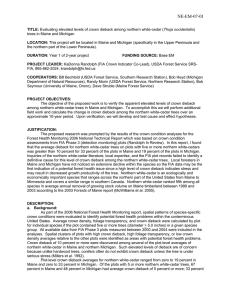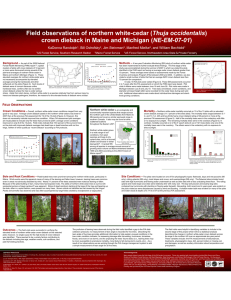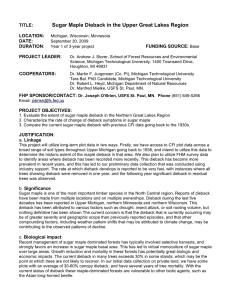Proposal: NE-EM-07-01 and the northern part of the Lower Peninsula).
advertisement

Proposal: NE-EM-07-01 TITLE: Evaluating Elevated Levels of Crown Dieback among Northern white-cedar (Thuja occidentalis) Trees in Maine and Michigan LOCATION: This project will be located in Maine and Michigan (specifically in the Upper Peninsula and the northern part of the Lower Peninsula). DURATION: Year 2 of 2-year project FUNDING SOURCE: Base EM PROJECT LEADER: KaDonna Randolph (FIA Crown Indicator Co-Lead), USDA Forest Service SRS-FIA, 865-862-2024, krandolph@fs.fed.us COOPERATORS: Bill Bechtold (USDA Forest Service, Southern Research Station), Bob Heyd (Michigan Department of Natural Resources), Randy Morin (USDA Forest Service, Northern Research Station), Bob Seymour (University of Maine, Orono), Dave Struble (Maine Forest Service) PROJECT OBJECTIVES: The objective of the proposed work is to verify the apparent elevated levels of crown dieback among northern white-cedar trees in Maine and Michigan. To accomplish this we will perform additional field work and calculate the change in crown dieback among the northern white-cedar trees over an approximate 10-year period. Upon verification, we will develop and test cause and effect hypotheses. JUSTIFICATION: The proposed research was prompted by the results of the crown condition analyses for the Forest Health Monitoring 2006 National Technical Report which was based on crown condition assessments from FIA Phase 3 (detection monitoring) plots (Randolph In Review). In this report, I found that the average dieback for northern white-cedar trees on plots with five or more northern white-cedars was greater than 10 percent for 33 percent of the plots in Maine and 19 percent of the plots in Michigan. Inquiries of the northern white-cedar literature, local expertise, and the FIA plot records failed to identify a definitive cause for this level of crown dieback among the northern whitecedar trees. Local foresters in Maine and Michigan have not noticed an extensive decline within the species so the FIA data may be the first indication of a potential forest health issue since a high level of crown dieback indicates stress and may result in decreased growth productivity of the tree. Northern white-cedar is an ecologically and economically important species that ranges across the northern part of the United States from Maine to Minnesota and covers a similar range in southern Canada. Northern white-cedar ranked fifth among all species in average annual removal of growing stock volume on Maine timberland between 1999 and 2003 according to the 2003 Forests of Maine report (McWilliams et al. 2005). DESCRIPTION: a. Background: As part of the 2006 National Forest Health Monitoring report, spatial patterns of speciesspecific crown conditions were evaluated to identify potential forest health problems within the conterminous United States. Average crown density, foliage transparency, and crown dieback were calculated by plot for individual species if the plot contained five or more trees (diameter > 5.0 inches) in a given species group. All available data from FIA Phase 3 plots measured between 2000 and 2004 were included in the analyses. Spatial clusters of plots with high crown dieback, high foliage transparency, or low crown density averages relative to the other plots were identified as areas with potential forest health problems. Crown dieback of 10 percent or more was discovered among several of the plot-level averages of northern white-cedar in Maine and northern Michigan. Such elevated Proposal: NE-EM-07-01 levels of dieback are of concern because unlike hardwood trees, conifers often do not exhibit crown dieback unless the tree is under serious stress (Millers et al. 1992). Plot-level crown dieback averages for northern white-cedar ranged from zero to 19 percent in Maine and zero to 33 percent in Michigan. Of the plots with 5 or more northern white-cedar trees, 67 percent in Maine and 48 percent in Michigan had average crown dieback of 5 percent or more; 33 percent and 19 percent had average crown dieback of 10 percent or more in Maine and Michigan, respectively. Steinman (2000) reported that softwood trees with more than 20 percent crown dieback were most likely to die within one year. In Maine, 5.6 percent of the northern white-cedar trees had more than 20 percent dieback; only 0.8 percent of the other softwoods had more than 20 percent dieback. Likewise in Michigan, 6.3 percent of the northern white-cedar trees and 0.9 percent of the other softwoods had more than 20 percent dieback. In an evaluation of forest health conditions between 1993 and 2002, Steinman (2004) mapped the percent of basal area with unhealthy crowns by county for several individual species in the Northeastern United States. The clusters of plots with elevated crown dieback averages generally corresponded to the counties with high percentages of northern white-cedar basal area with unhealthy crowns. In general, northern white-cedar is a species relatively free from serious injury by insect and disease pathogens; therefore, the reasons for the relatively high proportion of plots with elevated levels of dieback are unclear. Johnston (1990) notes that unfavorable winter weather, deicing salts, and drought are common agents that may cause foliage discoloration and lead to severe damage or death of northern white-cedars. Maine experienced one of the worst droughts in its history between 1999 and 2002 (Lombard 2004), and dry conditions also occurred between 1998 and 2002 in the Upper Peninsula and northern Lower Peninsula of Michigan (Steinman 2004). Thus, drought is a potential explanation. Other suggested causes include silvicultural practices, other weather events, and perhaps large seed crops. In Maine, occurrence of harvest or wind disturbance was recorded on two of the plots with more than 10% dieback. Residual stand stress may be the reason for the high dieback levels on these individual plots, but given the information available from the tree and plot records harvesting and specific weather events do not seem broadly applicable as reasons for the elevated levels of crown dieback. b. Methods: Evaluation of this forest health issue will require further analysis of the 2000-2004 data and collection of additional data. Plot averages from 2000-2004 will be examined by species to determine if the elevated levels of crown dieback are limited to the northern white-cedar trees. Crown dieback averages have been calculated at the plot-level for groupings of hardwoods and non-northern whitecedar softwoods. High averages for northern white-cedar were not necessarily accompanied by elevated averages among the hardwoods and other softwoods groups. Examination of crown dieback at the species level will provide greater insight into the breadth of the issue. Given the 5-year FIA data collection cycle, the Phase 3 plots measured in 2000 and 2001 should have been remeasured in 2005 and 2006, respectively. These data will be requested from Northern FIA and incorporated into the current dataset. Additionally, collection of crown condition data was conducted in Maine and Michigan by the Forest Health Monitoring Program as early as 1990. These historic datasets will be utilized as well. The project cooperators and I, along with other local forest insect and disease specialists, will visit the plots with average dieback of 10 percent or more. Many of the plots we desire to visit are located on privately owned lands. Pre-approval to obtain these plot locations has been granted by the Northern FIA Program Manager Dennis May and Spatial Data Services contact Liz LaPoint; however, access to the plots is ultimately dependent upon landowner approval. As feasible our plot visits will be scheduled to coincide with the regularly planned visit of the Federal or State FIA field crew. While on the plot, we will assess plot and tree conditions to help ascertain the causes of the high dieback levels. We will look specifically for evidence of leafminers and blight fungi that have been known to cause damage on northern white-cedars, as well as for disturbances or treatments that may have occurred on Proposal: NE-EM-07-01 or near the plot but that were not extensive enough to be recorded according to FIA definitions and protocols. Statistical analyses will be conducted with the historic FHM and recent FIA data to determine if crown dieback has increased or decreased over time. Auxiliary information (e.g. soil moisture, Palmer Drought Severity Index, and Forest Health Protection aerial survey data) will be incorporated into our analyses as potential explanatory variables for the poor conditions initially identified and for any changes that may have occurred during the remeasurement period. c. Products: 1. Poster presentations at annual FHM Working Grouping Meetings 2. Poster or paper presentation at state or regional meetings (e.g. Society of American Foresters) 3. Poster or paper presentation at FIA Symposium 4. Refereed journal article d. Schedule of Activities: • March 2007. FHM data (1990-1999) and FIA data (2000-2005) obtained from Northern FIA. • June/July 2007. FIA Phase 3 plots visited (10 in Maine, 8 in Michigan). • Fall 2007-Spring 2008. Analyze data and summarize results. • February 2008. Present findings at the FHM Work Group meeting. • Summer-Fall 2008. Complete draft peer reviewed journal article that presents final results. • October 2008. Present findings at FIA Symposium. e. Progress/Accomplishments Plots with an average cedar crown dieback greater than 10 percent based on the 2000-2004 FIA assessment were visited. For comparison, additional plots that had an average cedar crown dieback less than 10 percent were visited also. Tree status (live/dead), crown conditions, and diameter at breast height (dbh) were recorded for the cedar trees during each plot visit. Additional observations were made about individual-tree damages and standlevel growing conditions. The field visits verified the elevated levels of cedar crown dieback on the selected plots. There seemed to be a variety of factors contributing to the elevated dieback levels, including tree age, weather events, soil conditions, and past harvesting practices. Gaps in the data collection protocols which limit the interpretation of forest health conditions were identified and are being addressed. The field visits further identified variables to include in the analysis describing the change in crown dieback among the cedar trees over an approximate ten-year period. The FHM and FIA data for this analysis have been compiled and analytical approaches are being selected and refined. Northern white-cedar crown in good Northern white-cedar crown condition in poor condition. Proposal: NE-EM-07-01 COSTS: Item ------------- FY2008 ------------Requested FHM EM Funding Other-Source* Funding Administration Salary $8,000 Overhead Travel $4,500 $12,500 Total *Source: USDA Forest Service, Southern Research Station $8,700 $4,000 $12,700 References Lombard, P.J. 2004. Drought conditions in Maine, 1999-2002: a historical perspective. WaterResources Investigations Report 03-4310. Augusta, ME: U.S. Department of the Interior, Geological Survey. 36 p. Johnston, W.F. 1990. Northern white-cedar. In: Burns, R.M.; Honkala, B.H., tech. coords. Silvics of North America: 1. Conifers; 2. Hardwoods. Agriculture Handbook 654. Washington, DC: U.S. Department of Agriculture, Forest Service. p. 580-589. McWilliams, W.H.; Butler, B.J.; Caldwell, L.E. [and others]. 2005. The forests of Maine: 2003. Resour. Bull. NE-164. Newtown Square, PA: U.S. Department of Agriculture, Forest Service, Northeastern Research Station. 188 p. Millers, I.; Anderson, R.; Burkman, W.; Hoffard, W. 1992. Crown condition rating guide. Newtown Square, PA: U.S. Department of Agriculture, Forest Service, Northeastern Area State and Private Forestry; Atlanta: U.S. Department of Agriculture, Forest Service, Southern Region. 37 p. Randolph, K.C. In review. Crown condition. In: Forest Health Monitoring 2006 National Technical Report, M.J. Ambrose and B.L. Conkling (eds.). Asheville, NC: U.S. Department of Agriculture, Forest Service, Southern Research Station. Steinman, J. 2000. Tracking the health of trees over time on forest health monitoring plots. P. 334-339 In: Integrated tools for natural resources inventories in the 21st century, M. Hansen and T. Burk (eds.). Gen. Tech. Rep. NC-212. St. Paul, MN: U.S. Department of Agriculture, Forest Service, North Central Research Station. 743 p. Steinman, J. 2004. Forest health monitoring in the Northeastern United States: disturbances and conditions during 1993-2002. NA-TP-01-04. Newtown Square, PA: U.S. Department of Agriculture, Forest Service, Northeastern Area, State and Private Forestry. 46 p.




